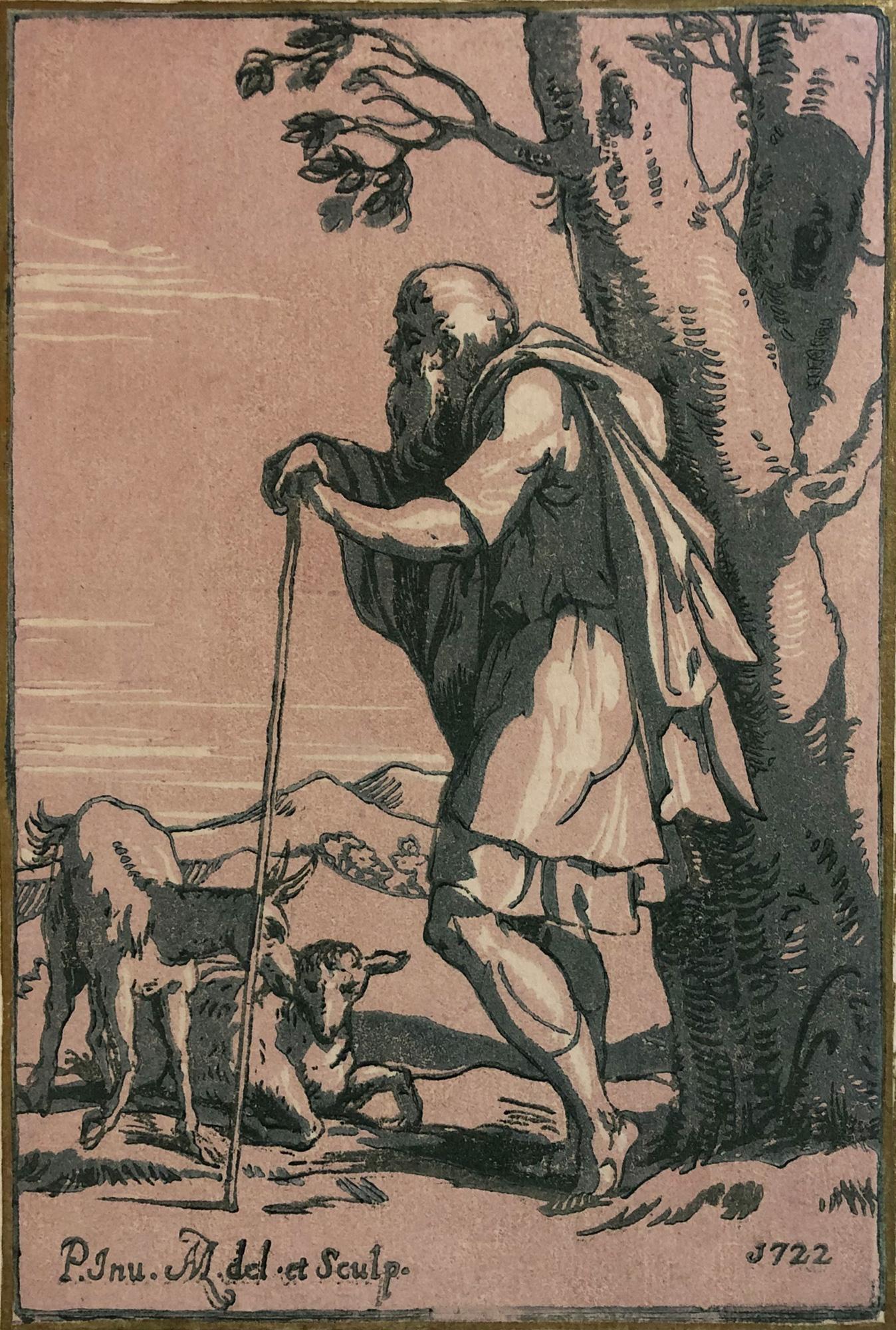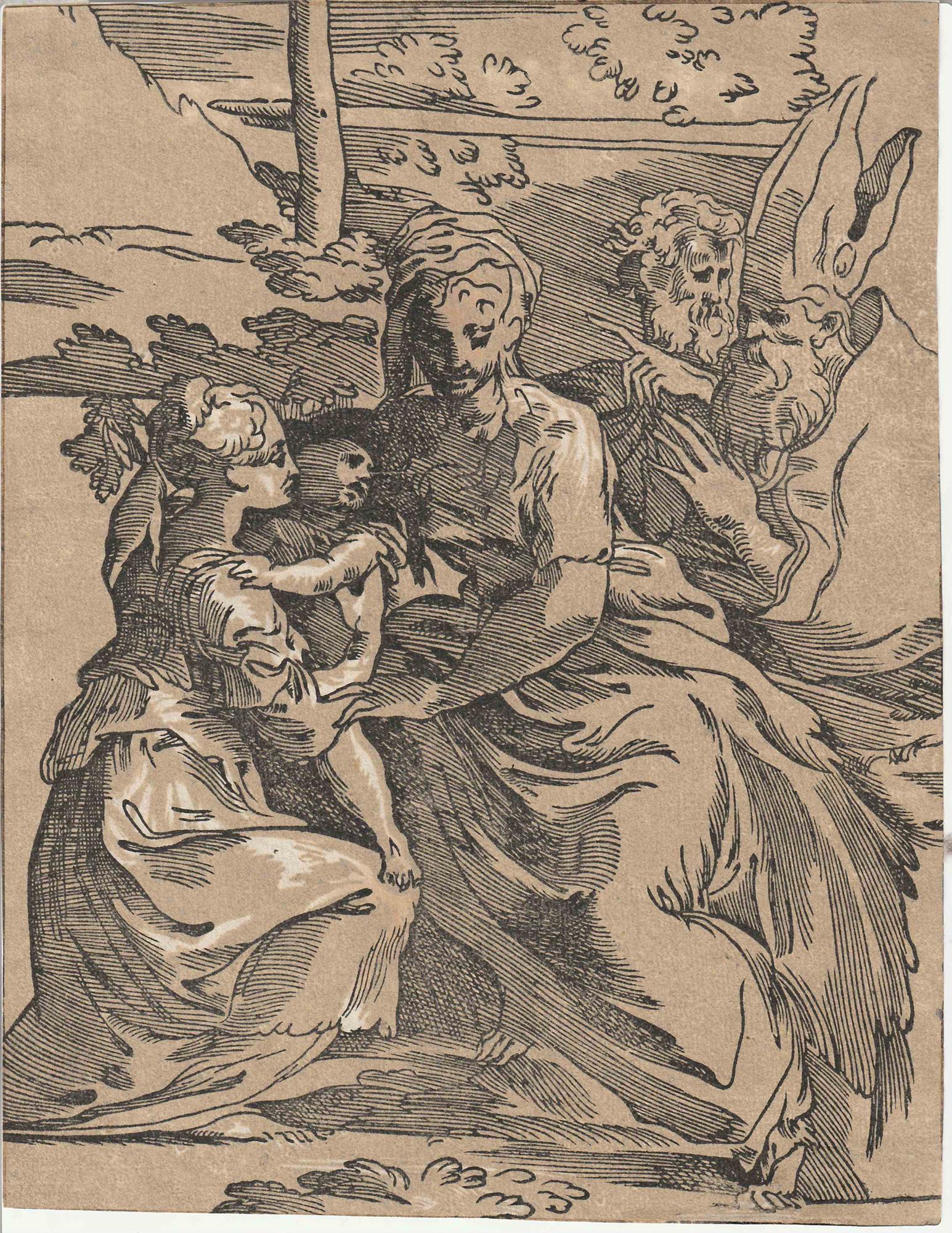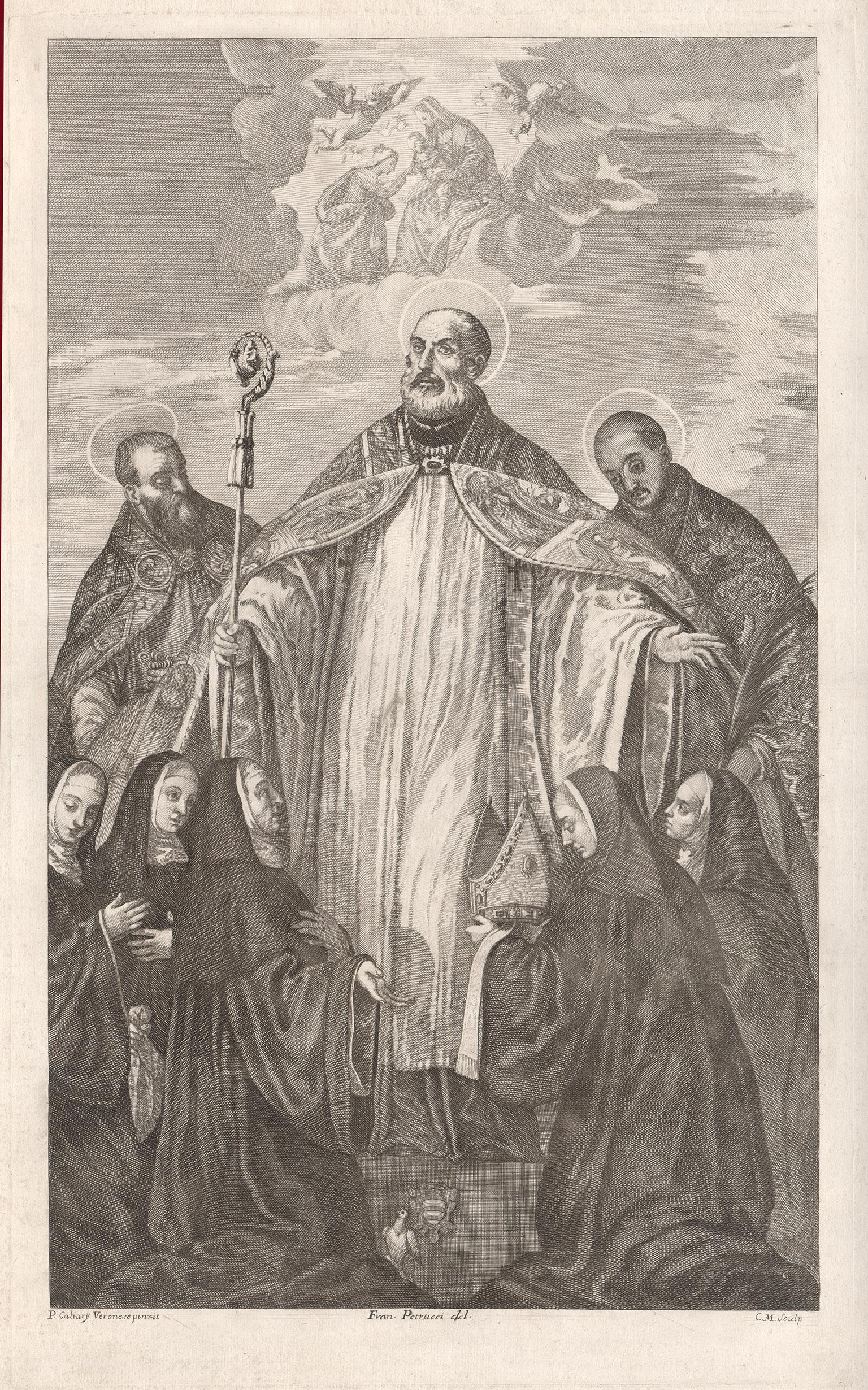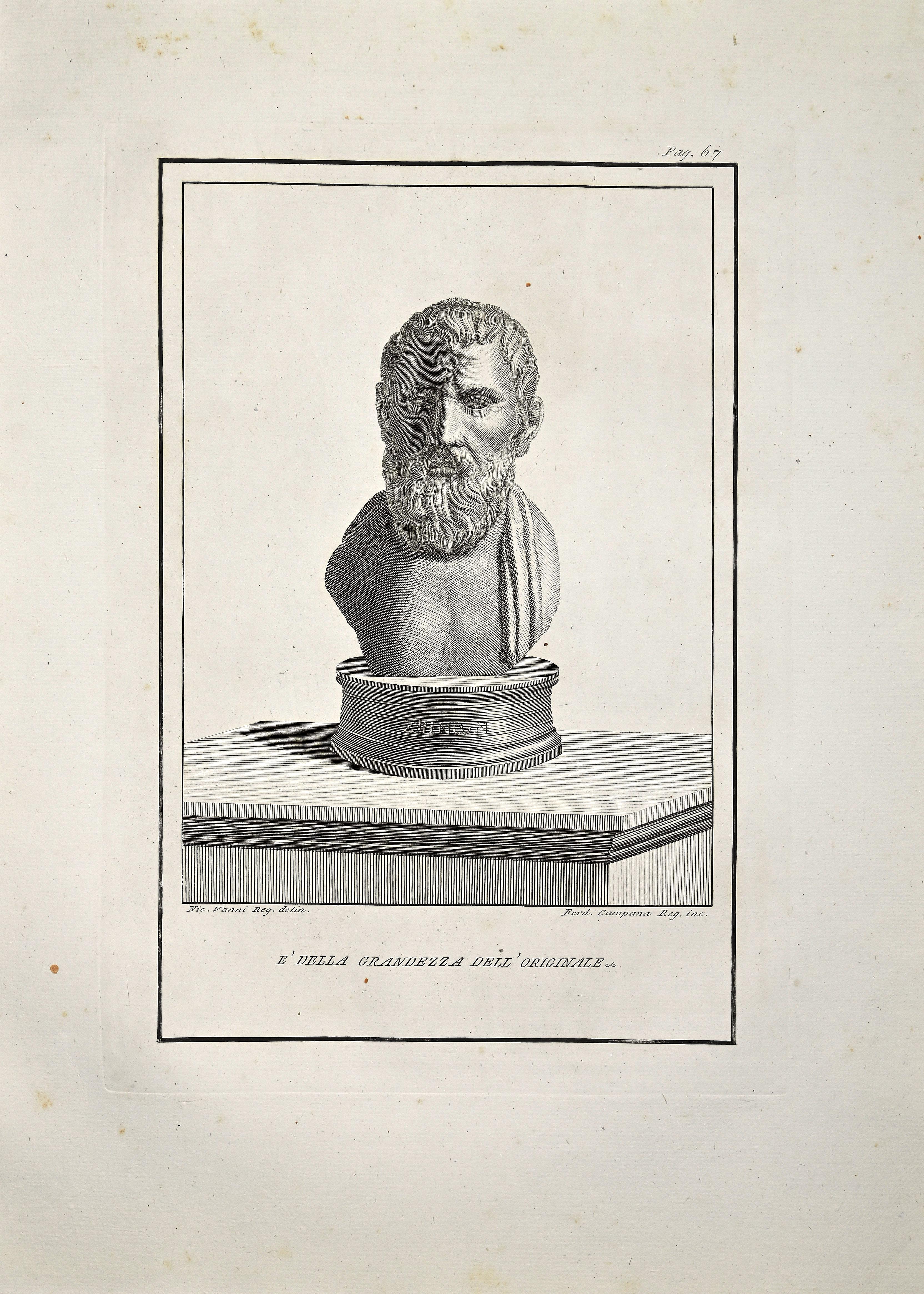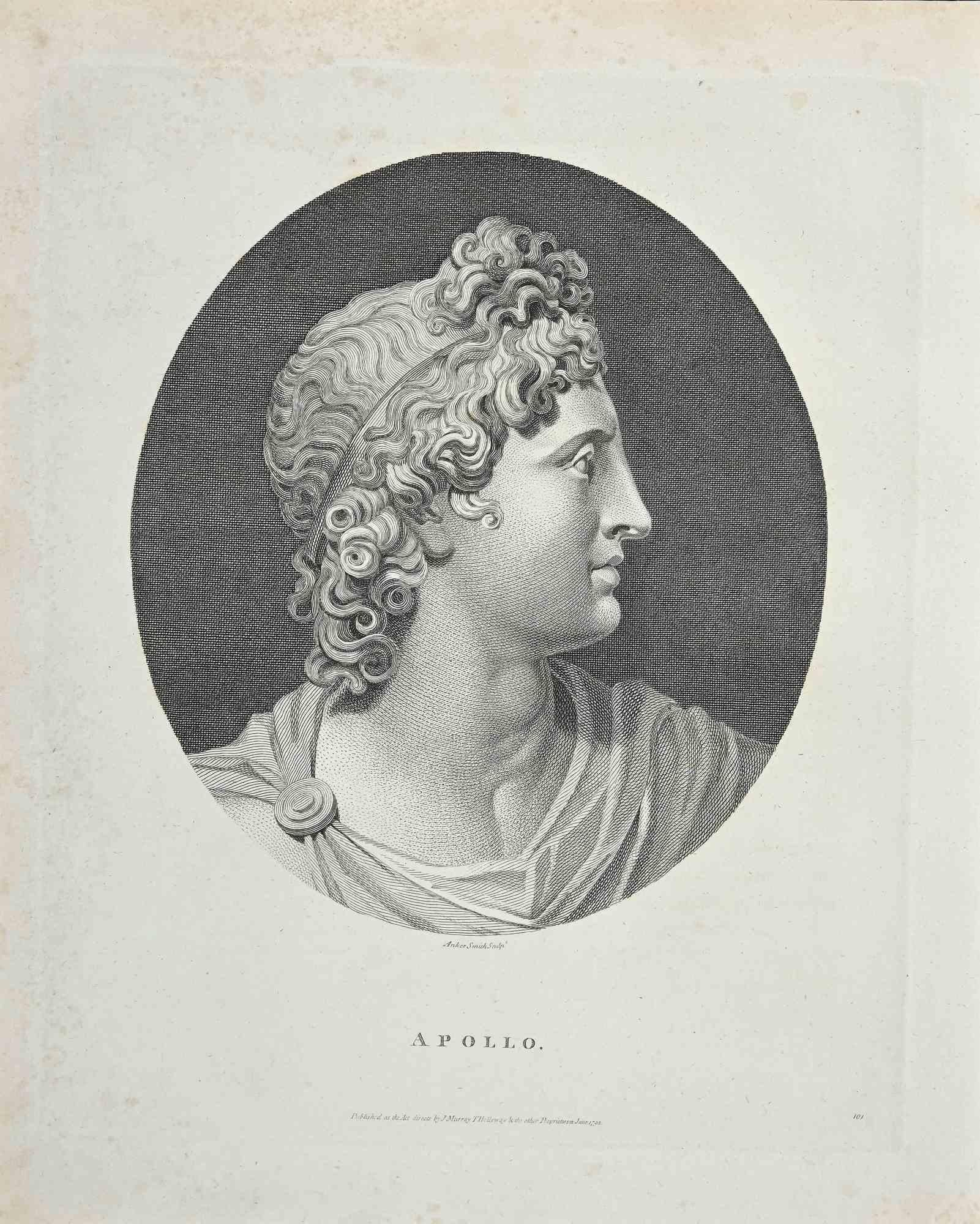Items Similar to Saint Simon, from Christ and the Apostles
Want more images or videos?
Request additional images or videos from the seller
Ludolf Ludwig BusinckSaint Simon, from Christ and the Apostles1620
1620
About the Item
Chiaroscuro woodcut on cream laid paper, printed from three blocks in black, olive-green, and yellow ochre, 8 3/16 x 6 1/4 inches (207 x 157 mm), thread margins. Some scattered light discoloration throughout, lightly backed with laid paper, however the sheet retains translucence when viewed through raking light. Trimmed at or near the margin. Archivally sound small repaired corner tear, upper right, with a very minor (1/4 inch) vertical edge split in the center top margin, above the figure's head. All condition issues are consistent with age, and present an exceptionally good example of this truly remarkable work. With the collector's stamp of Friedrich August II, King of Saxony, last King of Poland (1797-1854), Dresden, on the right corner, recto (Lugt 971). This work likely appeared in a well-known posthumous sale of Friedrich August II's private collection, which was handled by C.G. Boerner, and took place in Leipzig, on May 7-9, 1928, presumably this print was presented as lot 1551.
[Stechow 16]
Ludolph Busïnck was born at Hann, Germany around 1590. By about 1620 he was actively working as a printmaker in Paris, collaborating with publisher and celebrated cartographer Melchoir Tavernier. Busïnck may have studied printmaking in the Netherlands, evidenced by the influence of Dutch printmaker Hendrick Goltzius we see in the bold woodcuts he produced in France. Busïnck was the first printmaker to create chiaroscuro woodcuts in France, a technique originated by German artist Hans Burgkmair (1473–1531) in 1509. This technique adored by printmakers because of the depth of light and shadow it achieved, which evoked the tonality of ink wash drawings. Most of Busïnck's woodcuts were based on paintings by George Lallemande. His first woodcut, however, was after Abraham Bloemaert. Busïnck is not known to have produced any prints after 1630, the year in which he left Paris and returned to Germany to work as a customs official. He died at Münden on 15 January 1669.
Provenance: Friedrich August II, King of Saxony
Born Friedrich August Albrecht Maria Clemens Joseph Vincenz Aloys Nepomuk Johann Baptista Nikolaus Raphael Peter Xavier Franz de Paula Venatius Felix on May 18th, 1797, Friedrich August II was a political reformer who enjoyed a relatively uneventful reign. He was appointed to the throne by his childless uncle, King Anton. Friedrich August II had two childless marriages himself, and became increasingly less active in governing as he aged. Instead, he delved deeply into his interest in art and his passion for the sciences. He was an amateur botanist and collector of fossils, and he accumulated an impressive natural history collection. He traveled extensively, and was a guest of Queen Victoria in London in 1844. Friedrich August II died on August 8th, 1856 from injuries sustained in a carriage accident in Tyrol, Austria, where he was taking part in a botany expedition.
A major collector of print and drawings, his vast collection was sold in Leipzig by C.G. Boerner in three parts after his death. Two major sales in 1856 and 1900, and a third sale in 1927.
- Creator:Ludolf Ludwig Businck (1590 - 1669, German)
- Creation Year:1620
- Dimensions:Height: 8.19 in (20.81 cm)Width: 6.25 in (15.88 cm)
- Medium:
- Movement & Style:
- Period:Early 17th Century
- Condition:
- Gallery Location:Middletown, NY
- Reference Number:
About the Seller
5.0
Vetted Seller
These experienced sellers undergo a comprehensive evaluation by our team of in-house experts.
Established in 2004
1stDibs seller since 2022
30 sales on 1stDibs
Typical response time: 9 hours
- ShippingRetrieving quote...Ships From: Middletown, NY
- Return PolicyA return for this item may be initiated within 30 days of delivery.
More From This SellerView All
- Hercule Gaulois, ou L’ÉloquenceBy Charles-Nicolas II CochinLocated in Middletown, NYA classical chiaroscuro woodcut after Raphael executed by Charles Nicolas Cochin Père (1688-1754) & Vincent Le Sueur (1668-1743) . Printed from two bloc...Category
Early 18th Century Old Masters Figurative Prints
MaterialsLaid Paper, Woodcut
- Elderly Shepherd Leaning on a Staff (after Parmigianino)Located in Middletown, NYA lovely chiaroscuro woodcut by Antonio Maria Zanetti the elder after a work by Parmigianino (Girolamo Francesco Maria Mazzola). Printed on cream laid paper, laid down to a cream lai...Category
Early 18th Century Old Masters Figurative Prints
MaterialsLaid Paper, Woodcut
- Holy Family with Two Saints, after ParmigianinoBy Antonio Da TrentoLocated in Middletown, NYChiaroscuro woodcut on cream laid paper with a partial anchor in a circle watermark, printed from two blocks in black and olive-green, 10 3/4 x 8 3...Category
16th Century Old Masters Figurative Prints
MaterialsLaid Paper, Ink, Woodcut
- Louis XI, Roi de FranceBy Jean MorinLocated in Middletown, NYEtching, engraving and stippling on cream laid paper with an indiscernible watermark in the sheet center, 11 15/16 x 8 3/16 inches (302 x 207 mm), trimmed at the plate mark. A very g...Category
Mid-17th Century Old Masters Portrait Prints
MaterialsLaid Paper, Engraving, Etching
- Portrait of Carlos de Colonna, Marques de la EspinarBy Paulus PontiusLocated in Middletown, NY(after Anthonie Van Dyck) Engraving on cream laid paper, 9 1/4 x 6 3/8 inches (234 x 161 mm), full margins. Water stain throughout bottom, diagonal creases in the area of the bottom right corner, paper tape along top edge on recto. A very well inked impression. __________Flemish painter and engraver Paulus Pontius was born in Antwerp in 1603, and it was in this city that his full life would unfold. At the young age of 13, he was apprenticed to the still life painter Osias Beert, and subsequently to Lucas Vosterman, who was heavily associated with the workshop of Peter Paul Rubens. Vosterman trained Pontius in the skill of engraving, which he took to immediately, finding he had great skill at recreating paintings. Pontius was able to capture the minutiae of light and shadow found on the canvas, and mastered the ability to accurately render the subtleties of brushwork in this alternate media. His success as an engraver cemented his role in the workshop of Rubens, and in 1624, when Vosterman found himself at odds with Rubens, and left Antwerp for England, Pontius assumed his role as foremost engraver in the workshop. It was in this year that Pontius took up lodgings in Rubens's home, and continued to live there until 1631, when courtship and marriage (the first of three) brought him away. After the death of Rubens in 1640, Pontius embarked on a very successful career engraving reproductions of master works by artists including Rubens, Anthony van Dyck, Jacob Jordaens, Pieter van Avont, Abraham van Diepenbeeck...Category
Mid-17th Century Old Masters Portrait Prints
MaterialsLaid Paper, Engraving
- To Drink in ExcessBy Cornelis VisscherLocated in Middletown, NYEtching on cream laid paper, full margins. Trimmed at the plate mark. Scattered light caramel colored areas of discoloration in the sheet corners, light skinning on the verso at the ...Category
Mid-17th Century Old Masters Portrait Prints
MaterialsEtching, Laid Paper
You May Also Like
- San Benedetto Con Altri Nanti, religious engraving after Veronese, circa 1700Located in Melbourne, VictoriaReligious copper-line engraving by CM after Francesco Petrucci after (Paolo Caliari) Veronese. Depicts Saint Benedict and other holy figures. Paolo Vero...Category
Early 1700s Old Masters Portrait Prints
MaterialsEngraving
- Ancient Roman Bust - Etching by Ferdinando Campana - Late 18 CenturyLocated in Roma, ITAncient Roman Bust, from the series "Antiquities of Herculaneum", is an original etching on paper realized by Ferdinando Campana. Signed on the plate, on the lower right. Good cond...Category
Late 18th Century Old Masters Figurative Prints
MaterialsEtching
- Portrait of God Apollo - Original Etching by Anker Smith - 1810By Anker SmithLocated in Roma, ITPortrait of Apollo is an original artwork realized by Anker Smith (1759 - 1819). Original Etching from J.C. Lavater's "Essays on Physiognomy, Designed to ...Category
1810s Old Masters Portrait Prints
MaterialsEtching
- Portrait of Raphael - Original Etching by William Bromley - 1810By William BromleyLocated in Roma, ITPortrait of Raphael is an original artwork realized by William Bromley (1769 - 1842). Original Etching from J.C. Lavater's "Essays on Physiognomy, Designed to promote the Knowledge ...Category
1810s Old Masters Portrait Prints
MaterialsEtching
- Ancient Roman Statue - Etching by Giovanni Morghen - 18th CenturyLocated in Roma, ITAncient Roman Statue, from the series "Antiquities of Herculaneum", is an original etching on paper realized by Giovanni Morghen in the 18th century. Signed on plate on the lower le...Category
18th Century Old Masters Figurative Prints
MaterialsEtching
- Ancient Roman Statue - Etching by Ferdinando Campana - 18th CenturyLocated in Roma, ITAncient Roman Statue, from the series "Antiquities of Herculaneum", is an original etching on paper realized by Ferdinando Campana in the 18th century. Signed on the plate, on the l...Category
18th Century Old Masters Figurative Prints
MaterialsEtching

